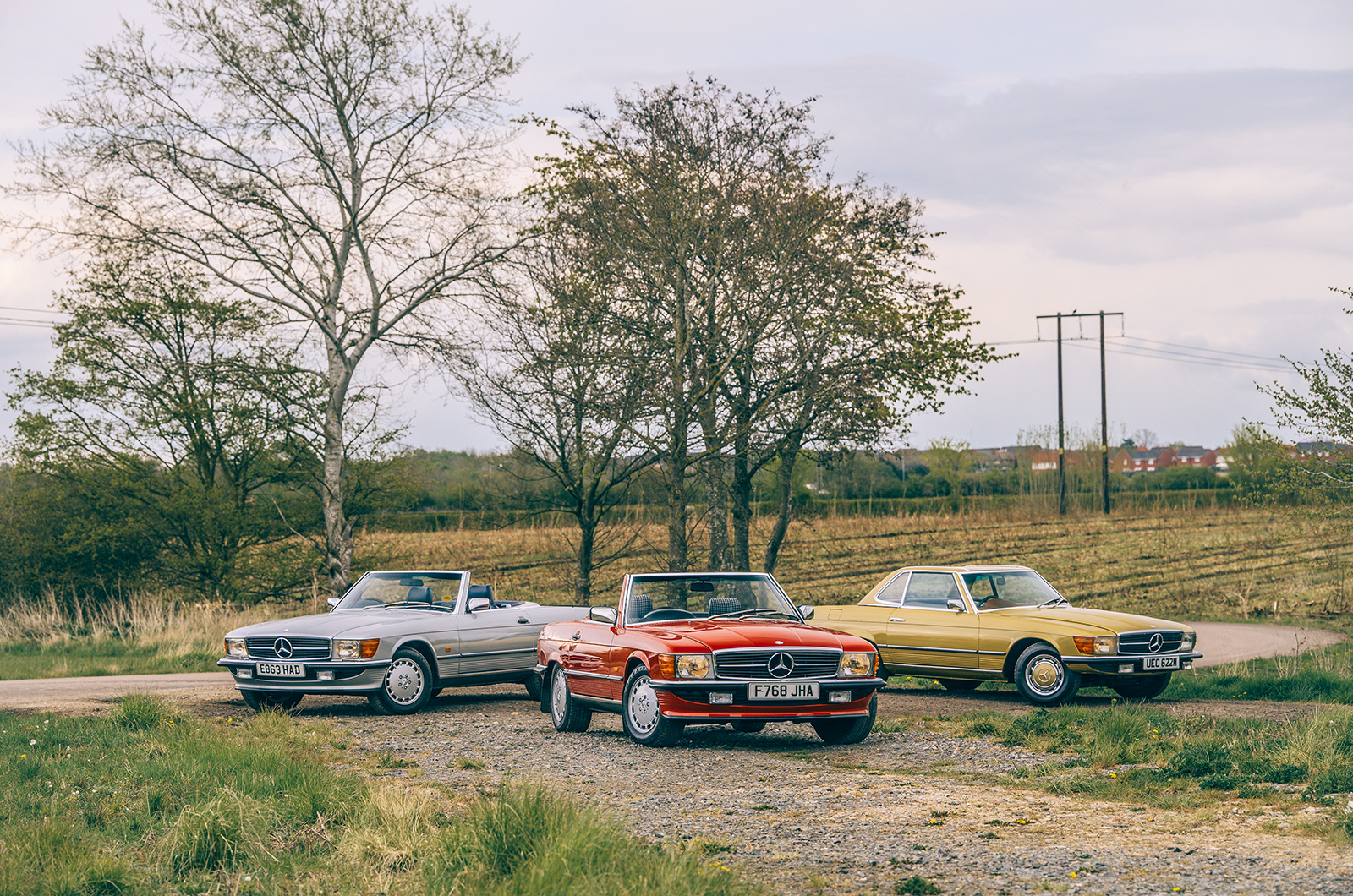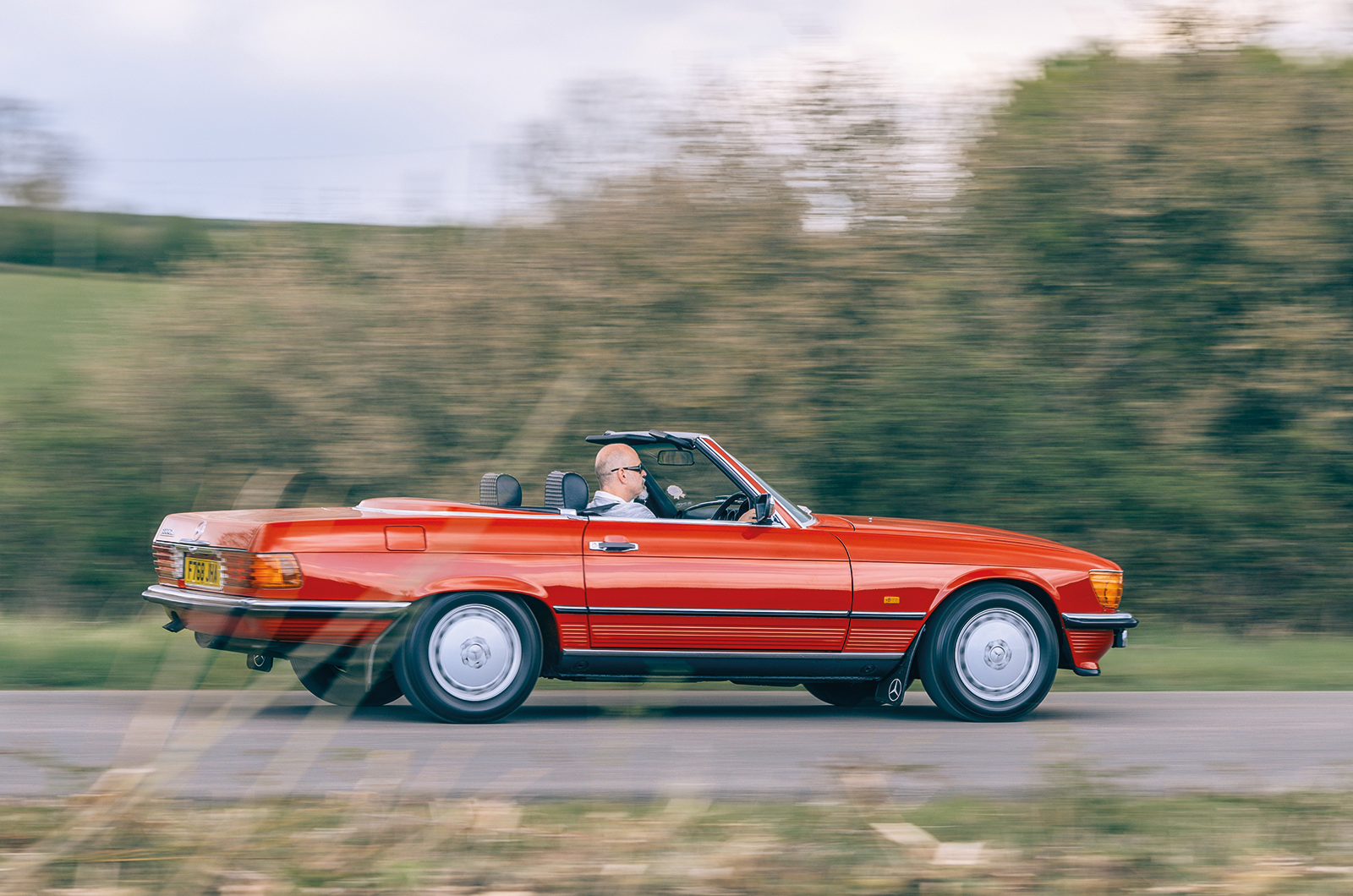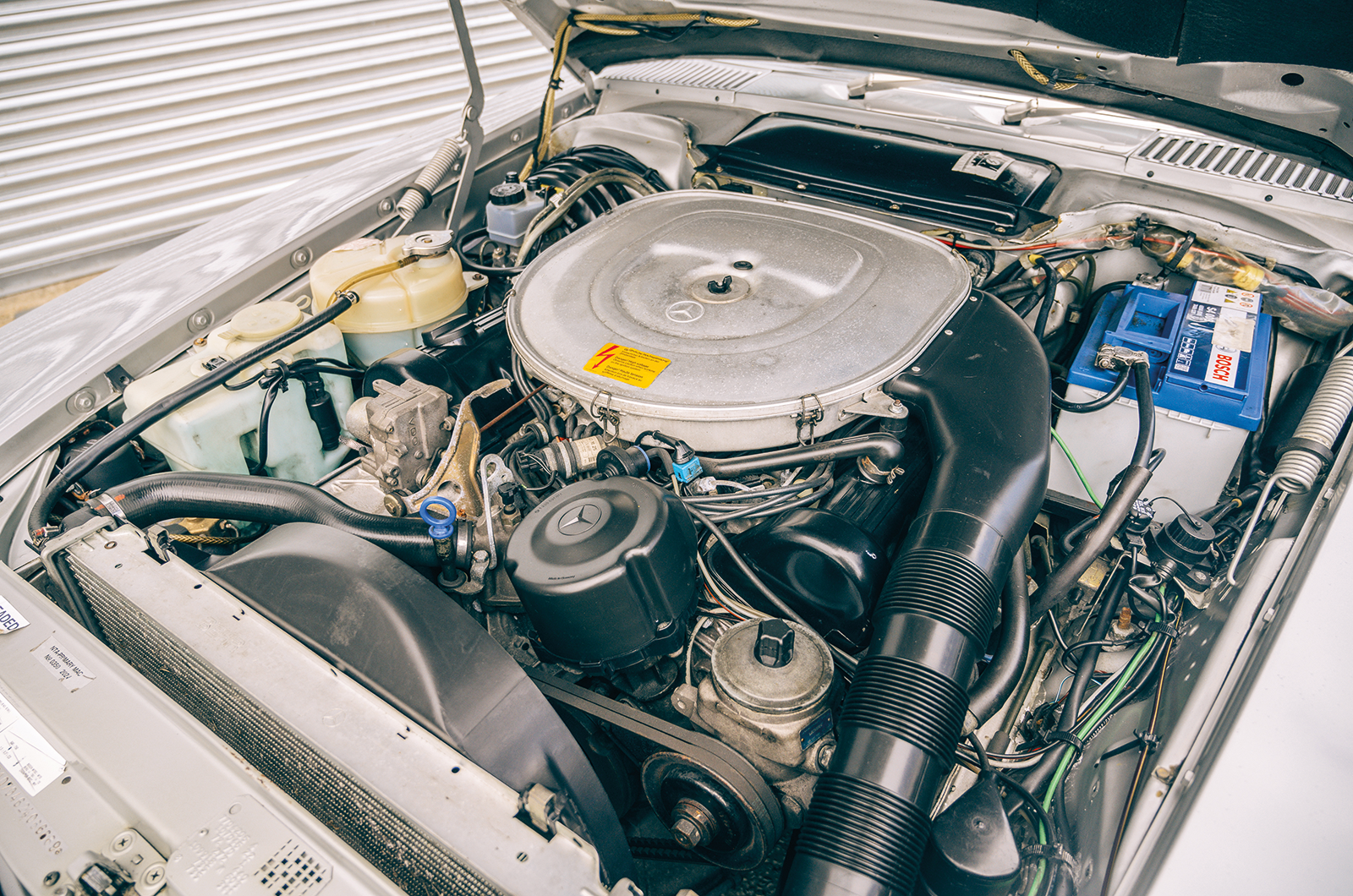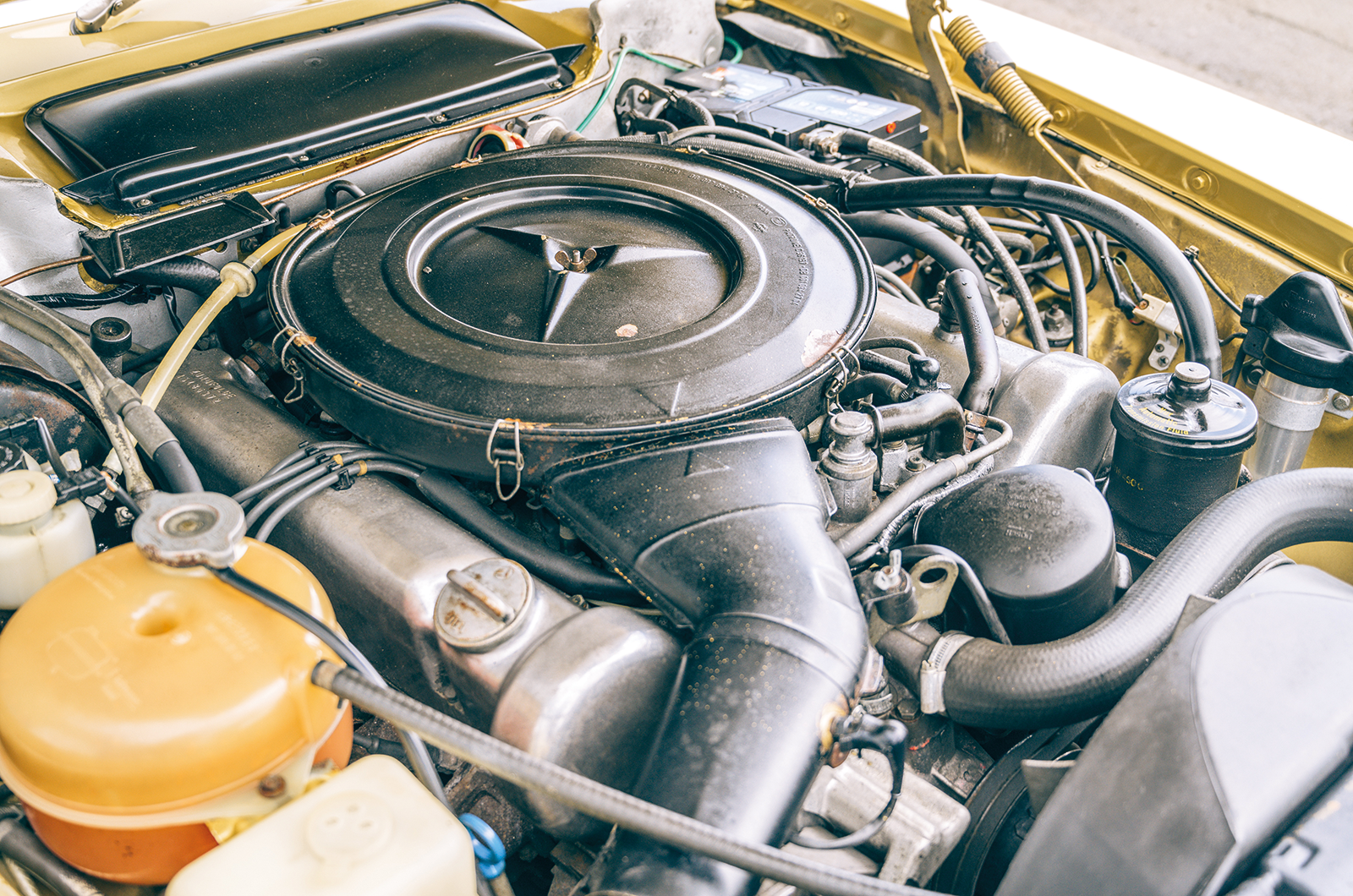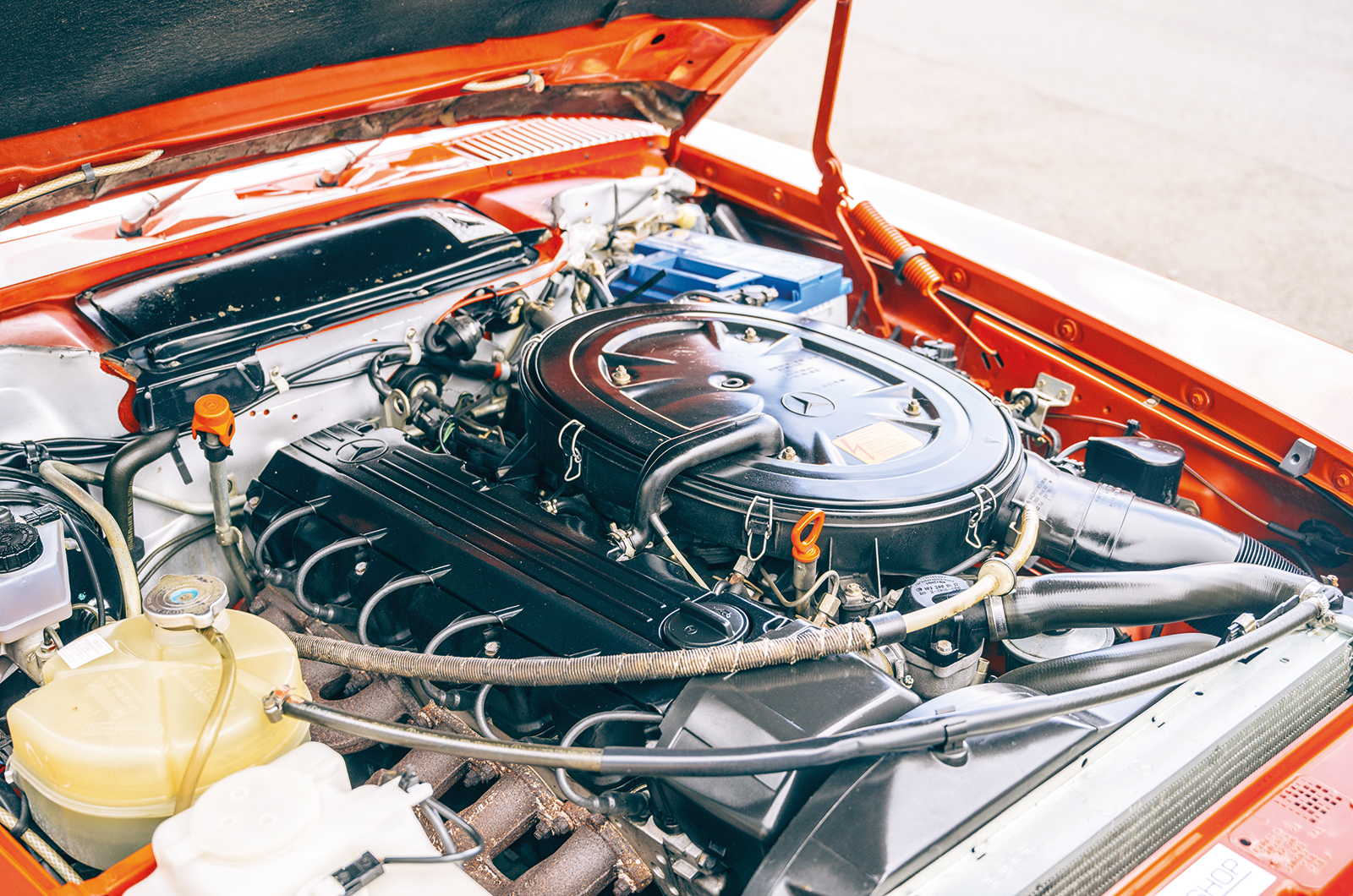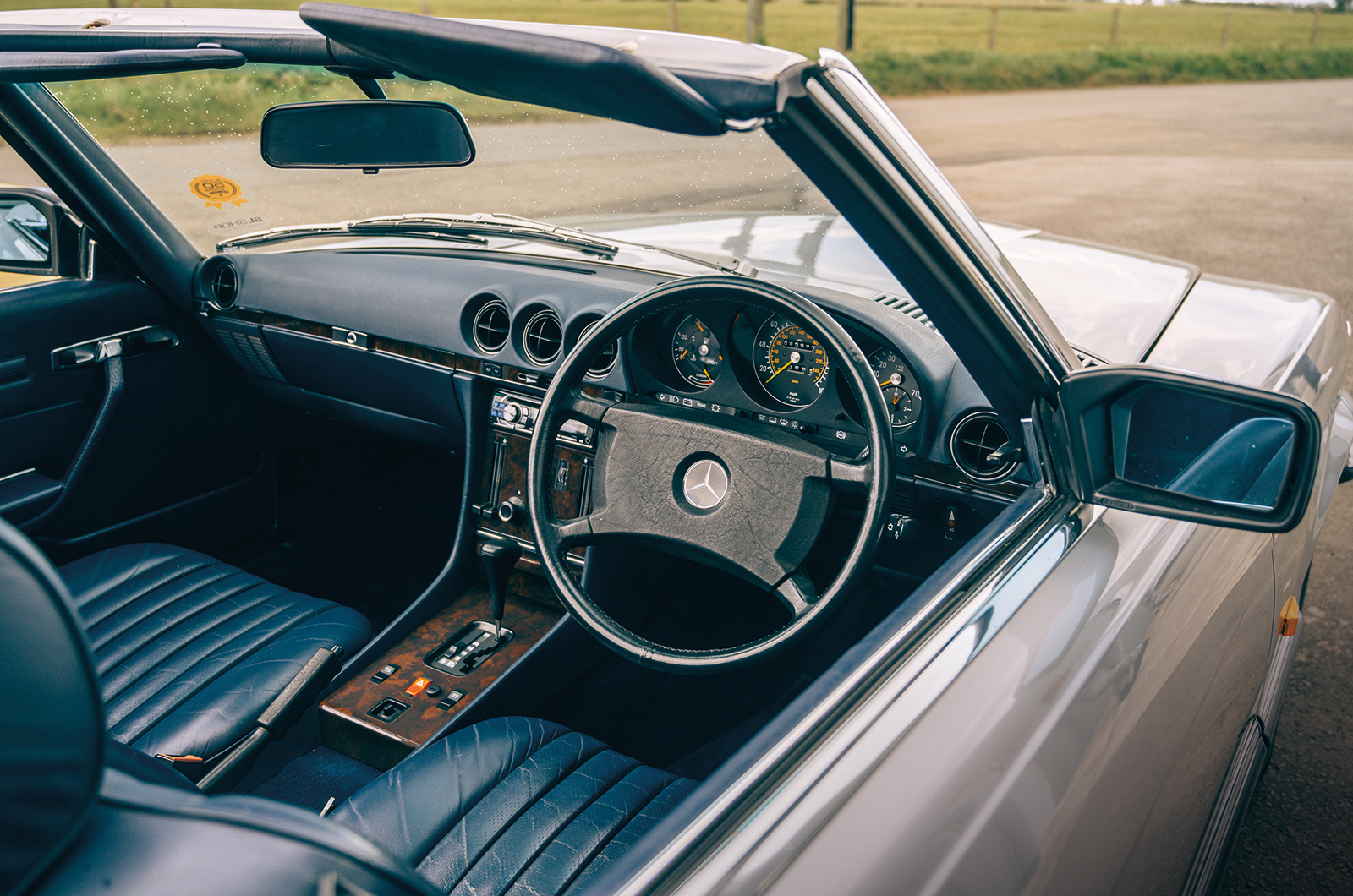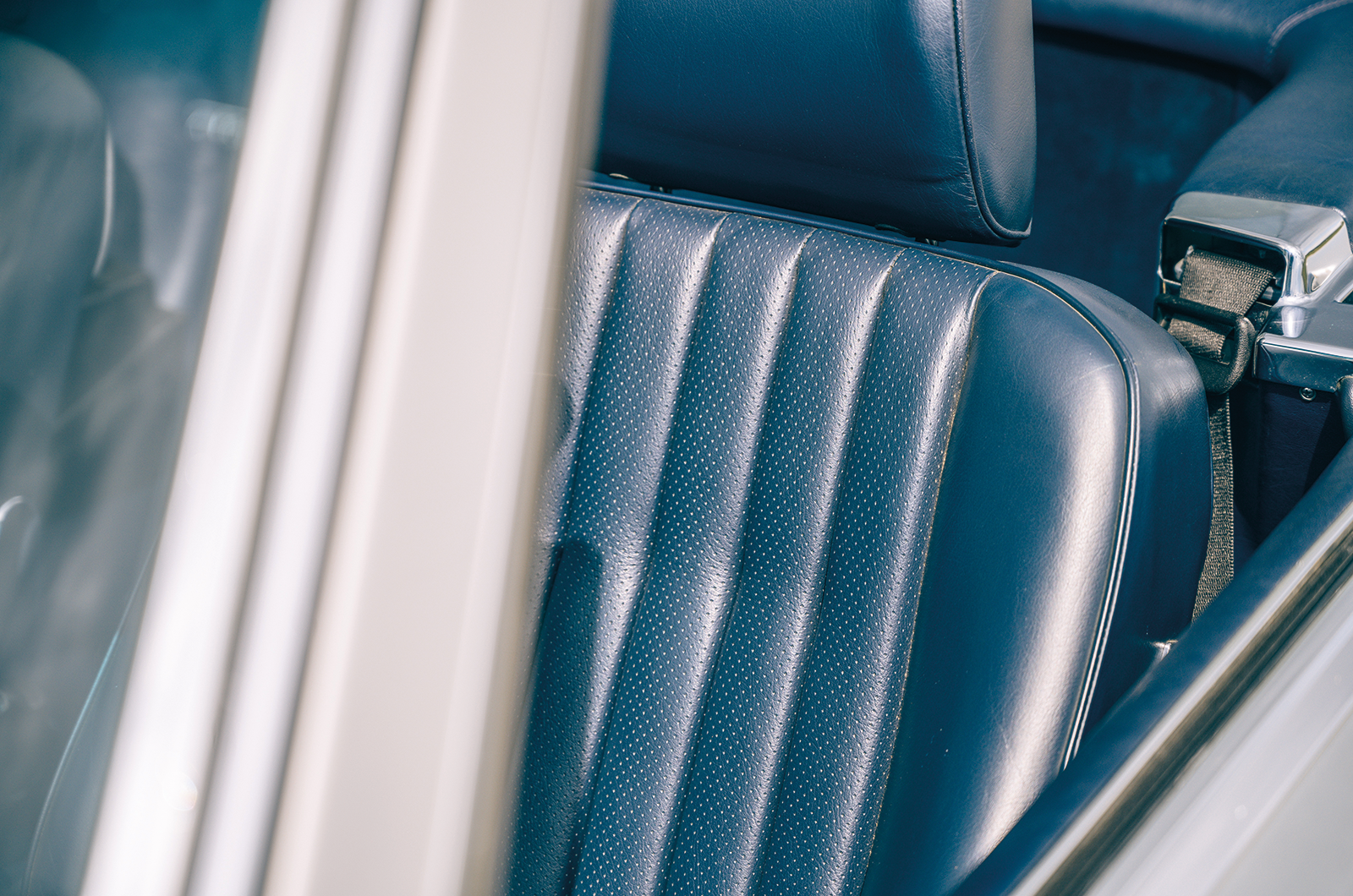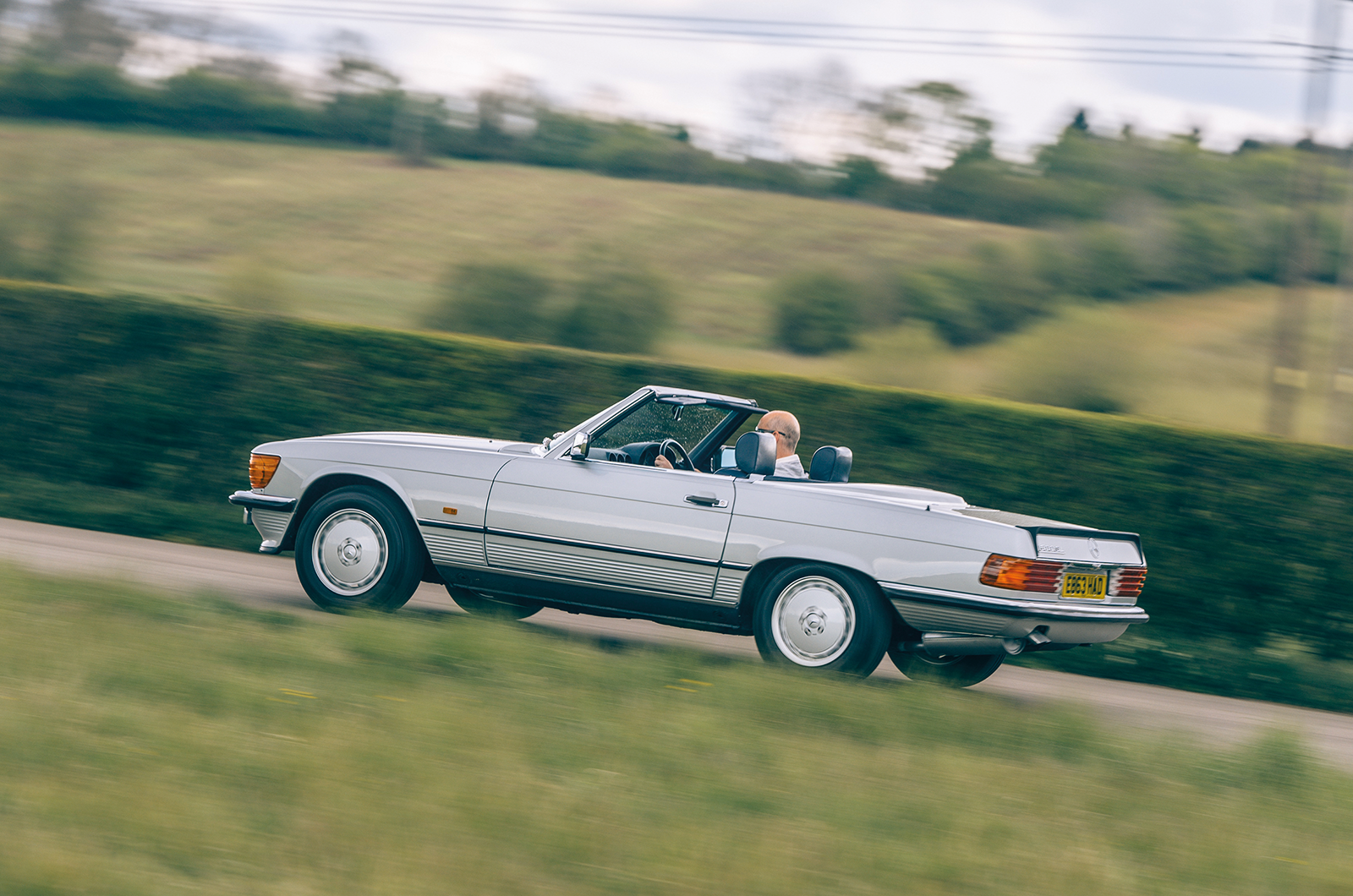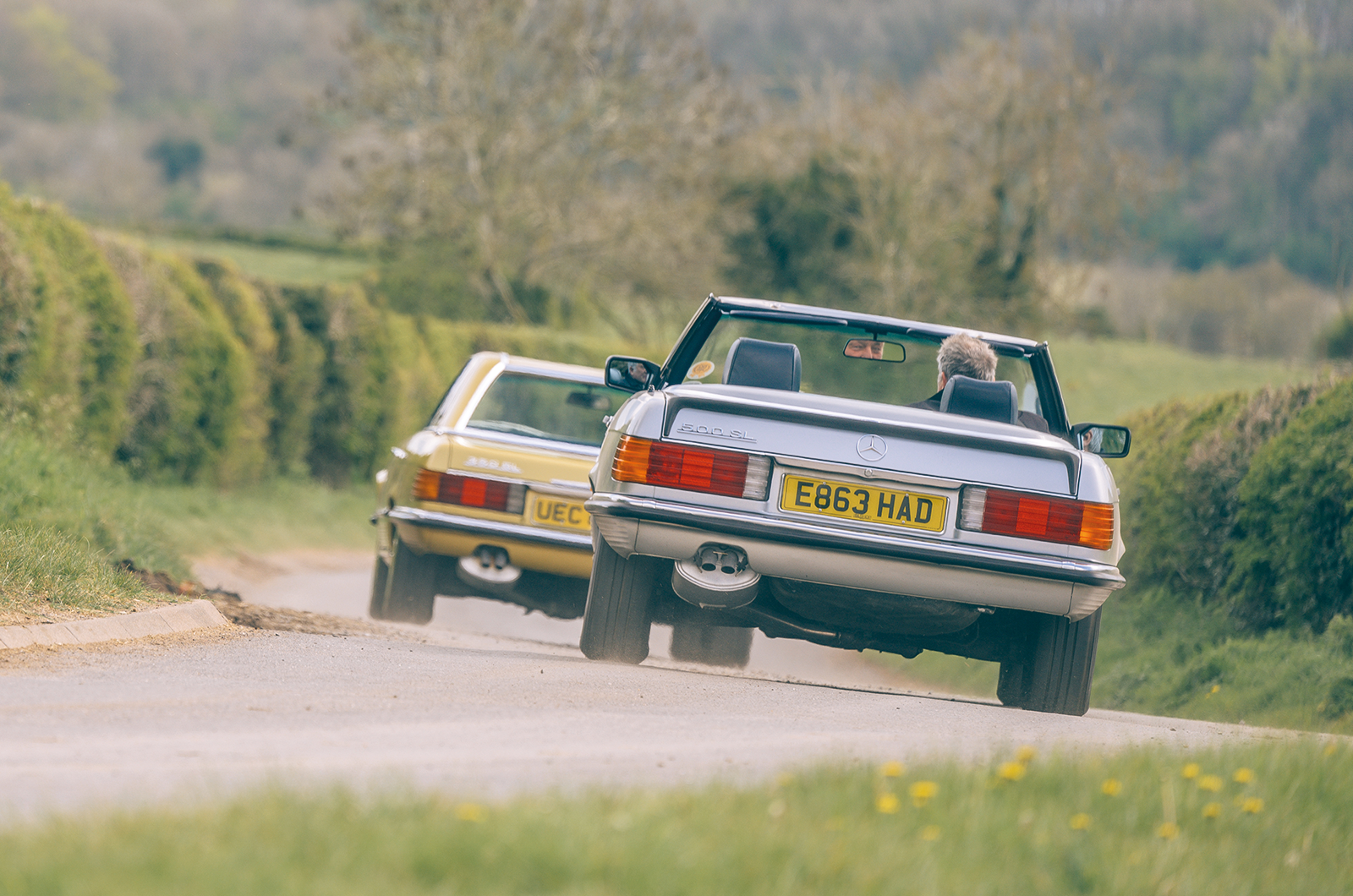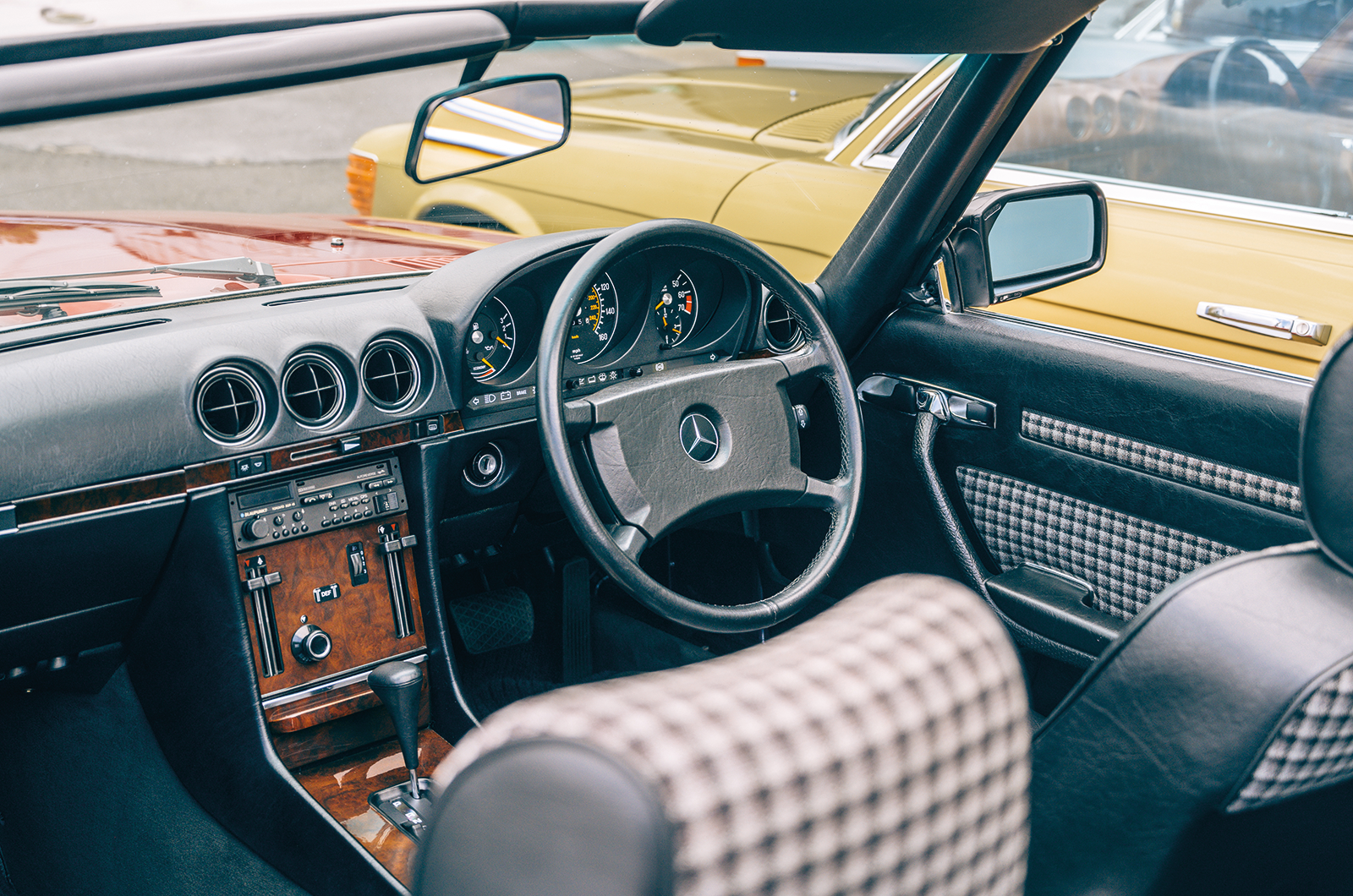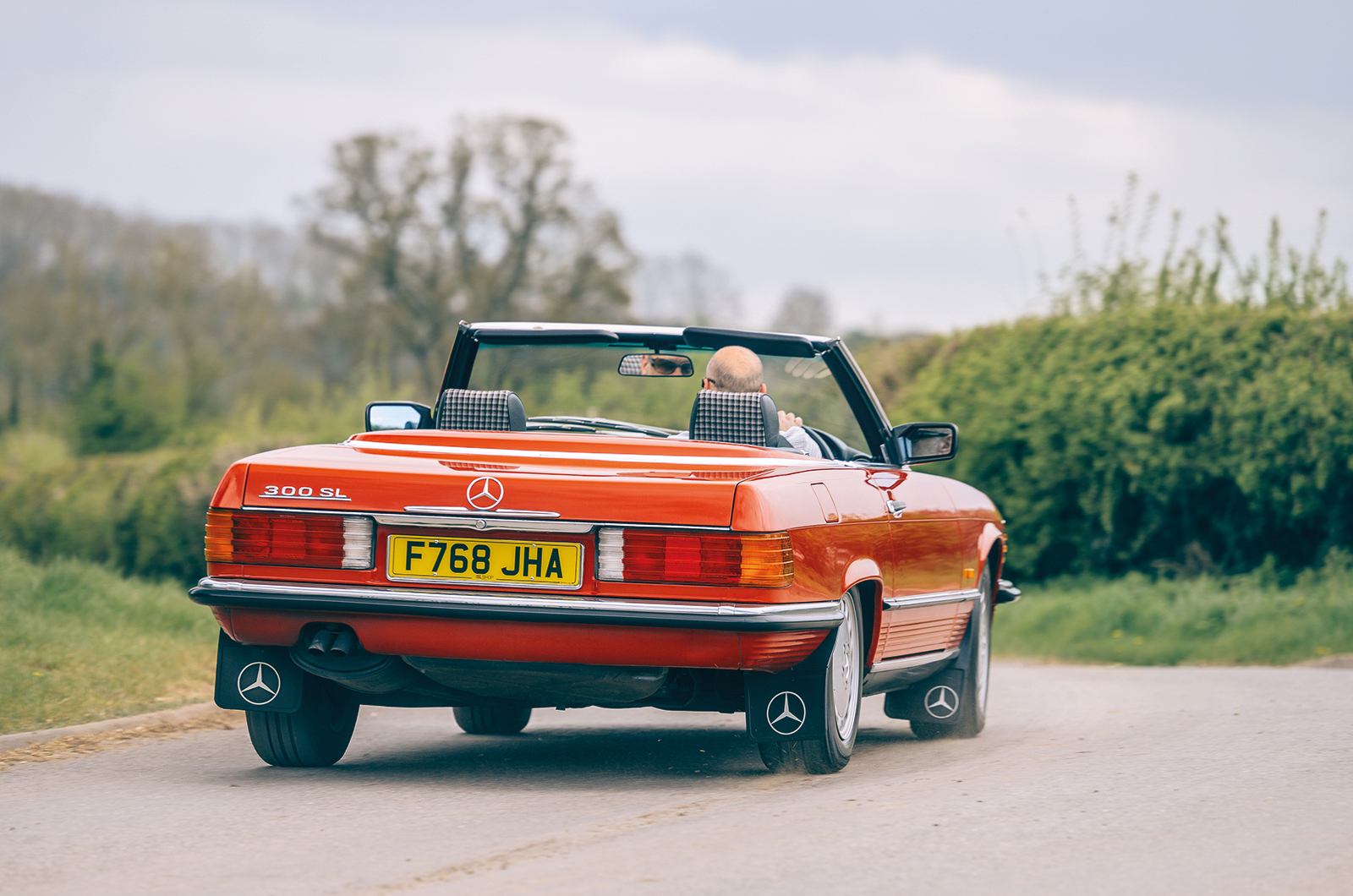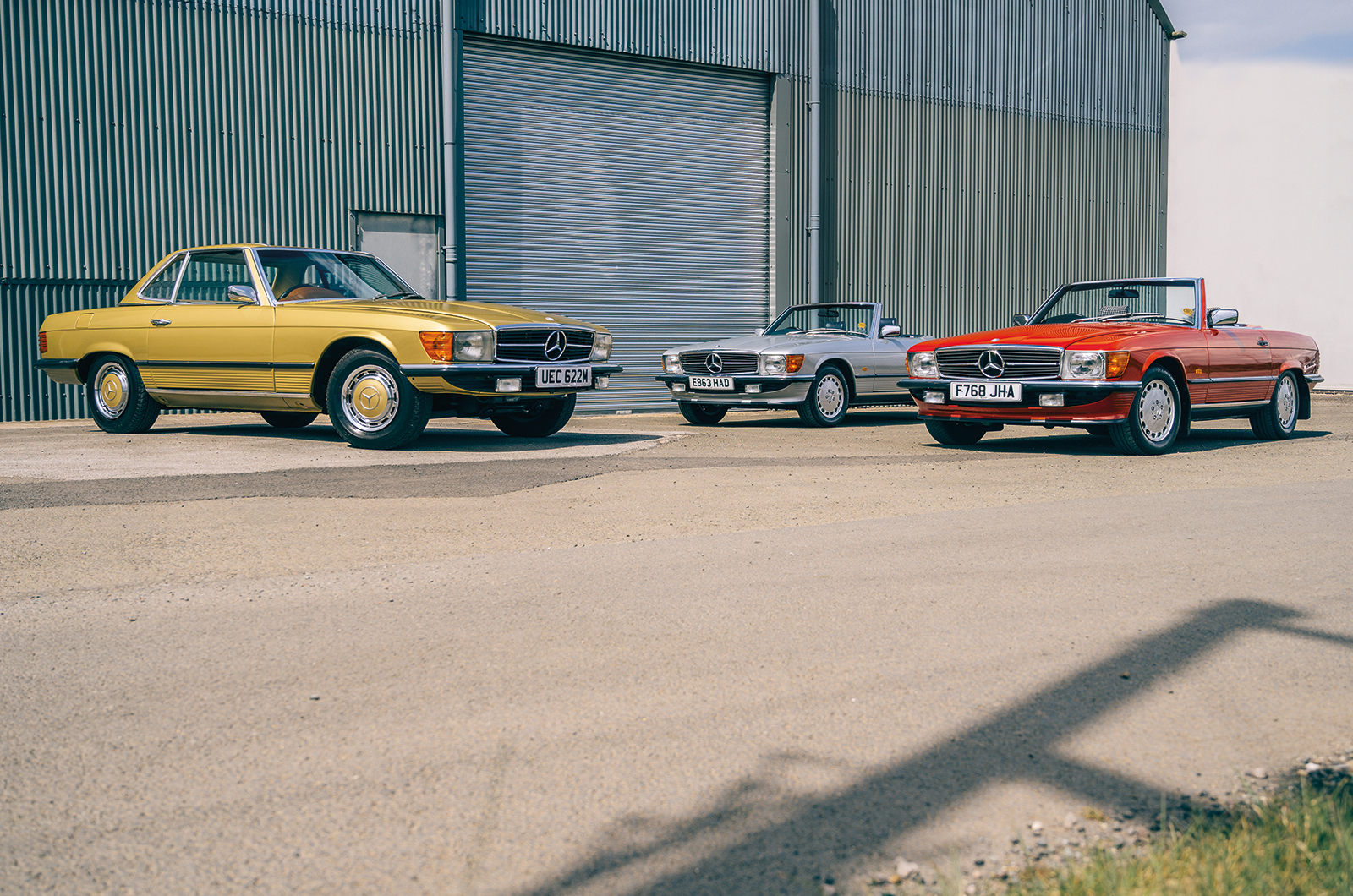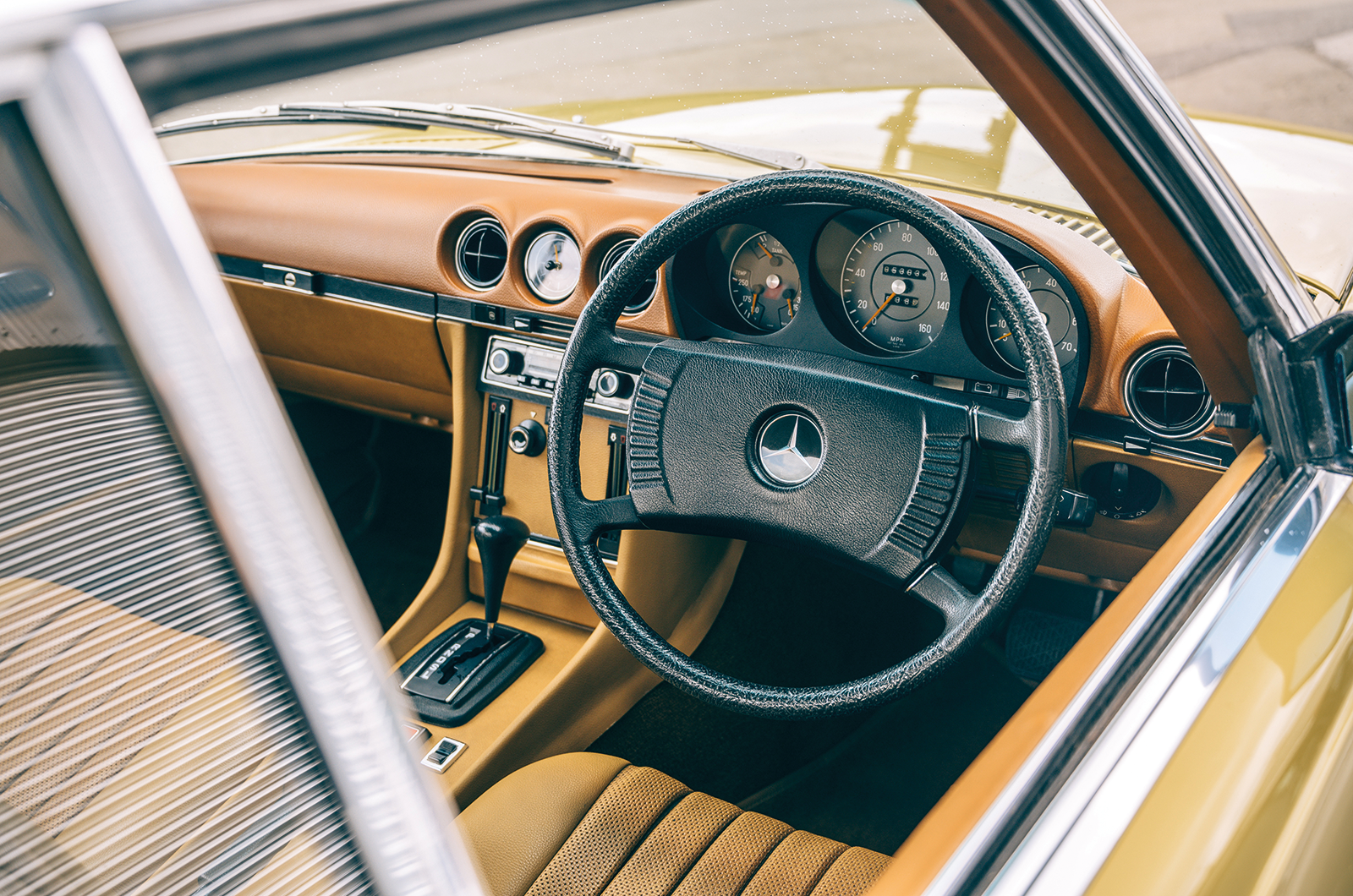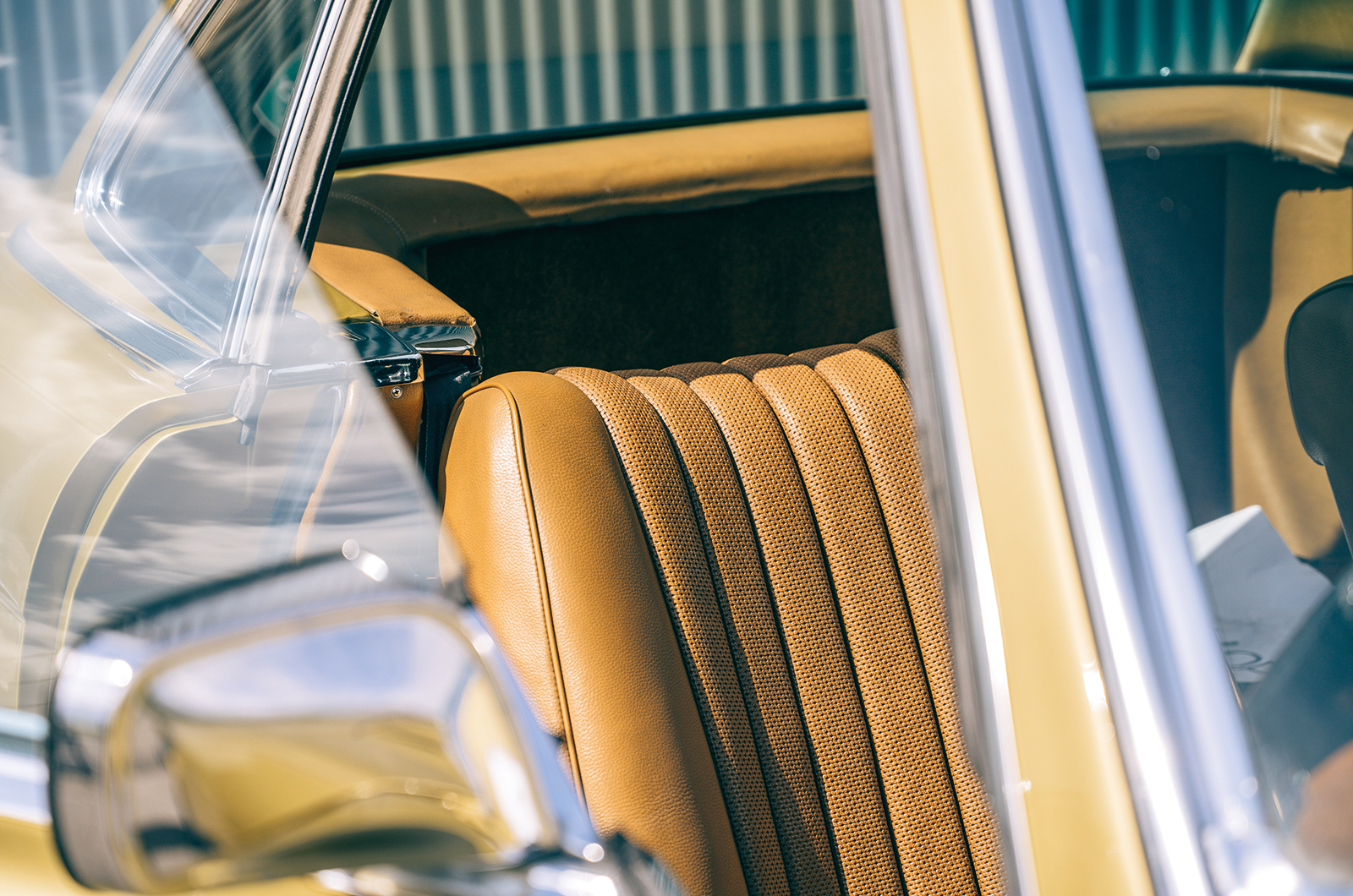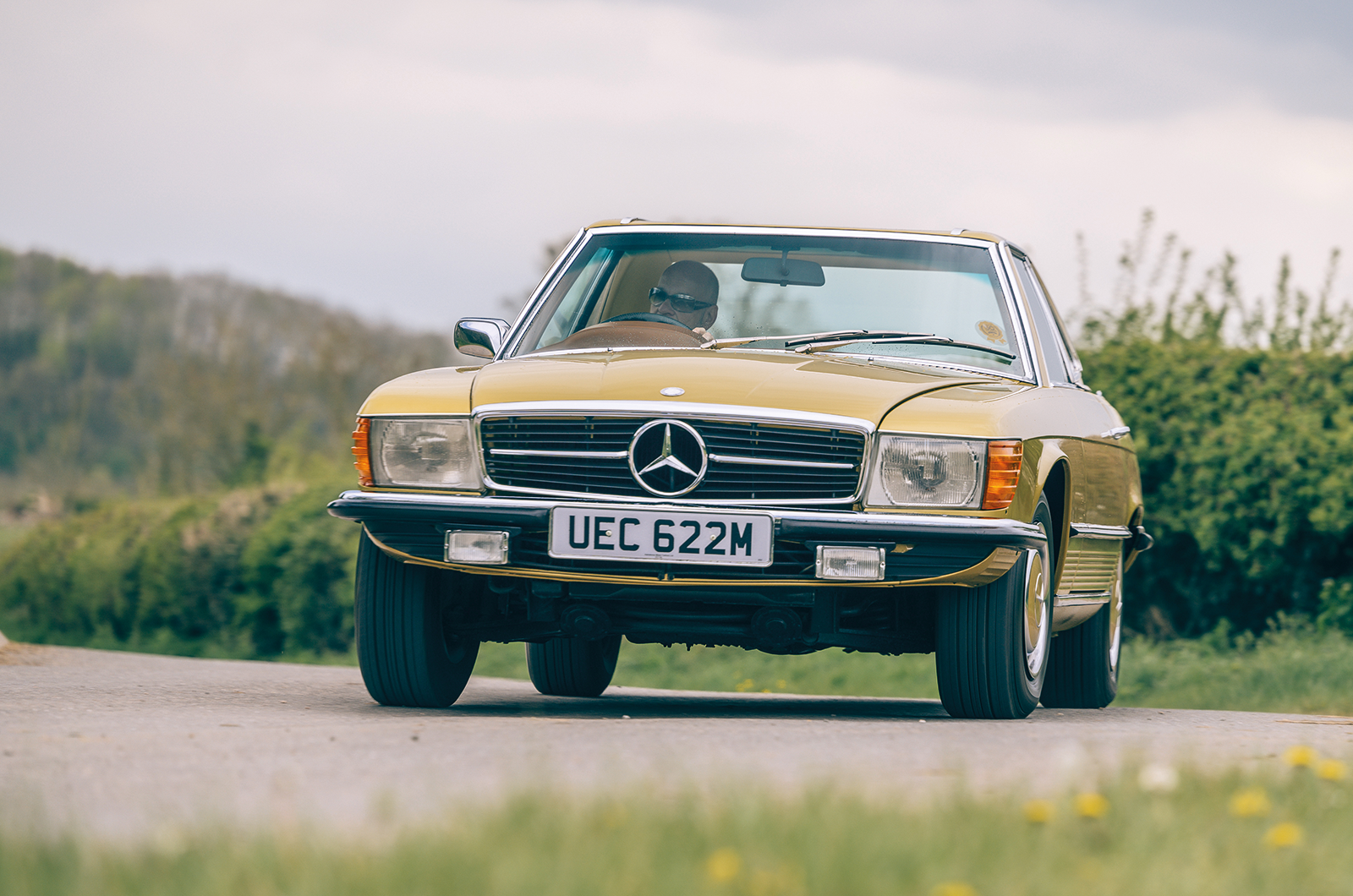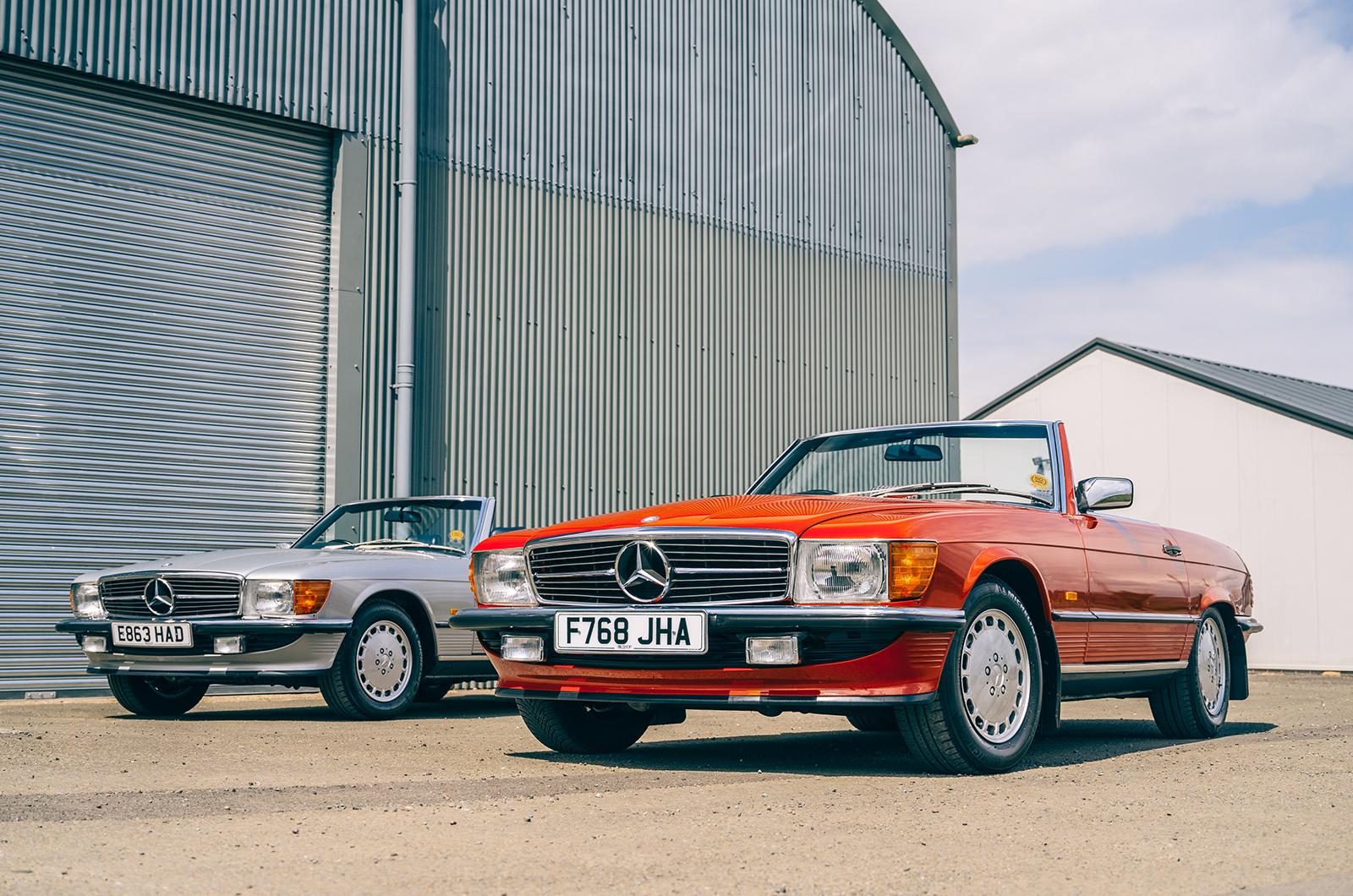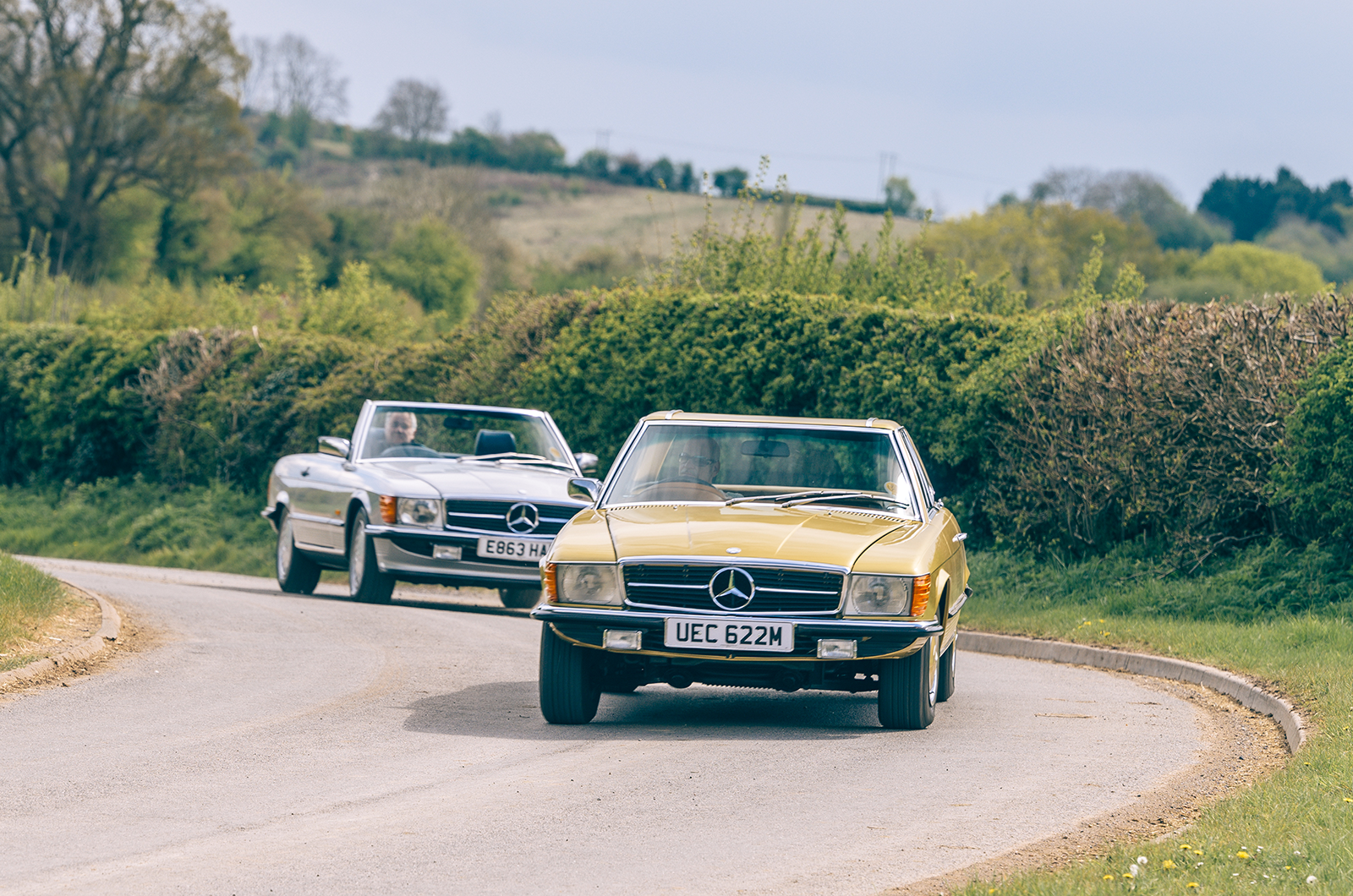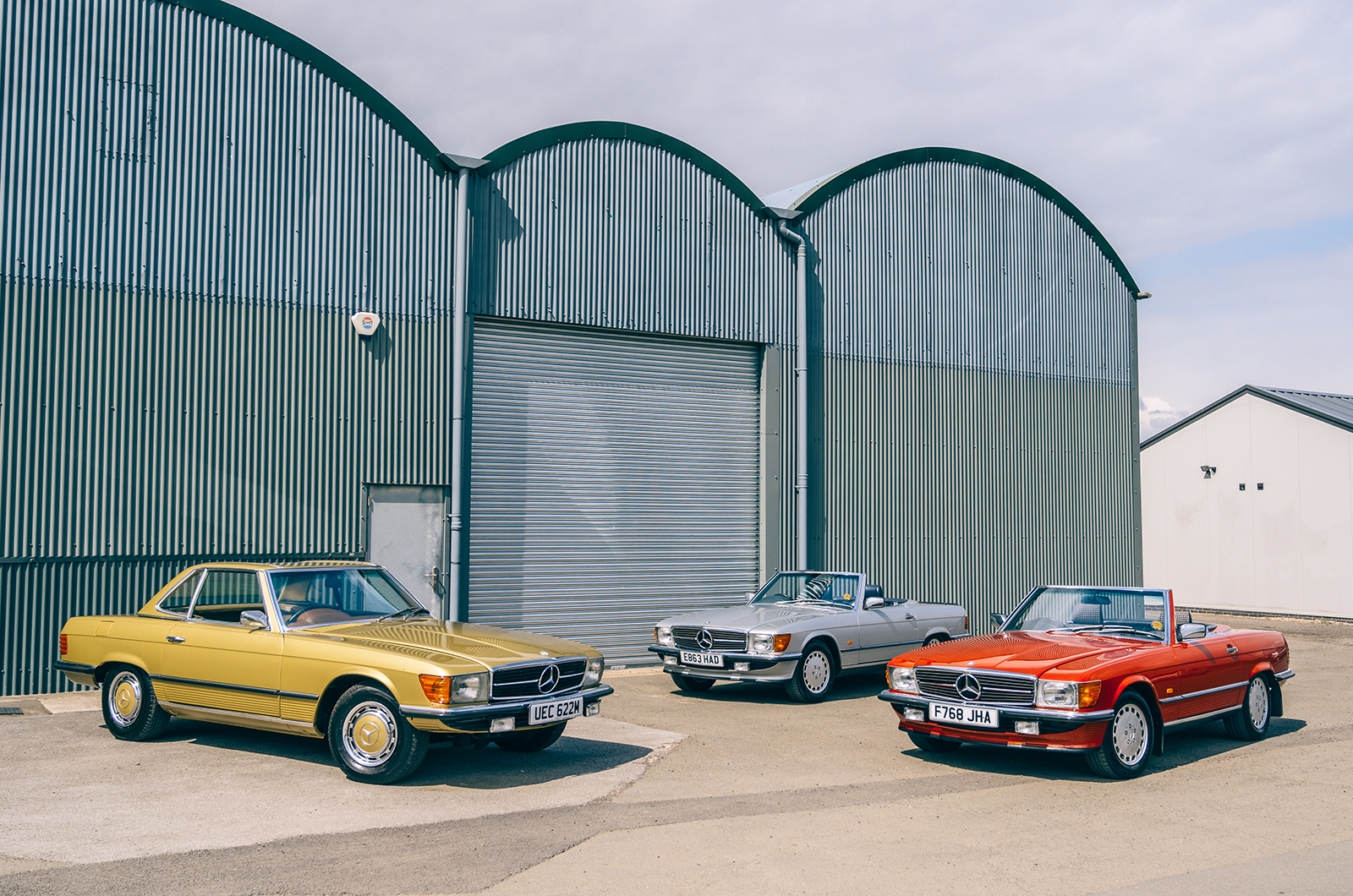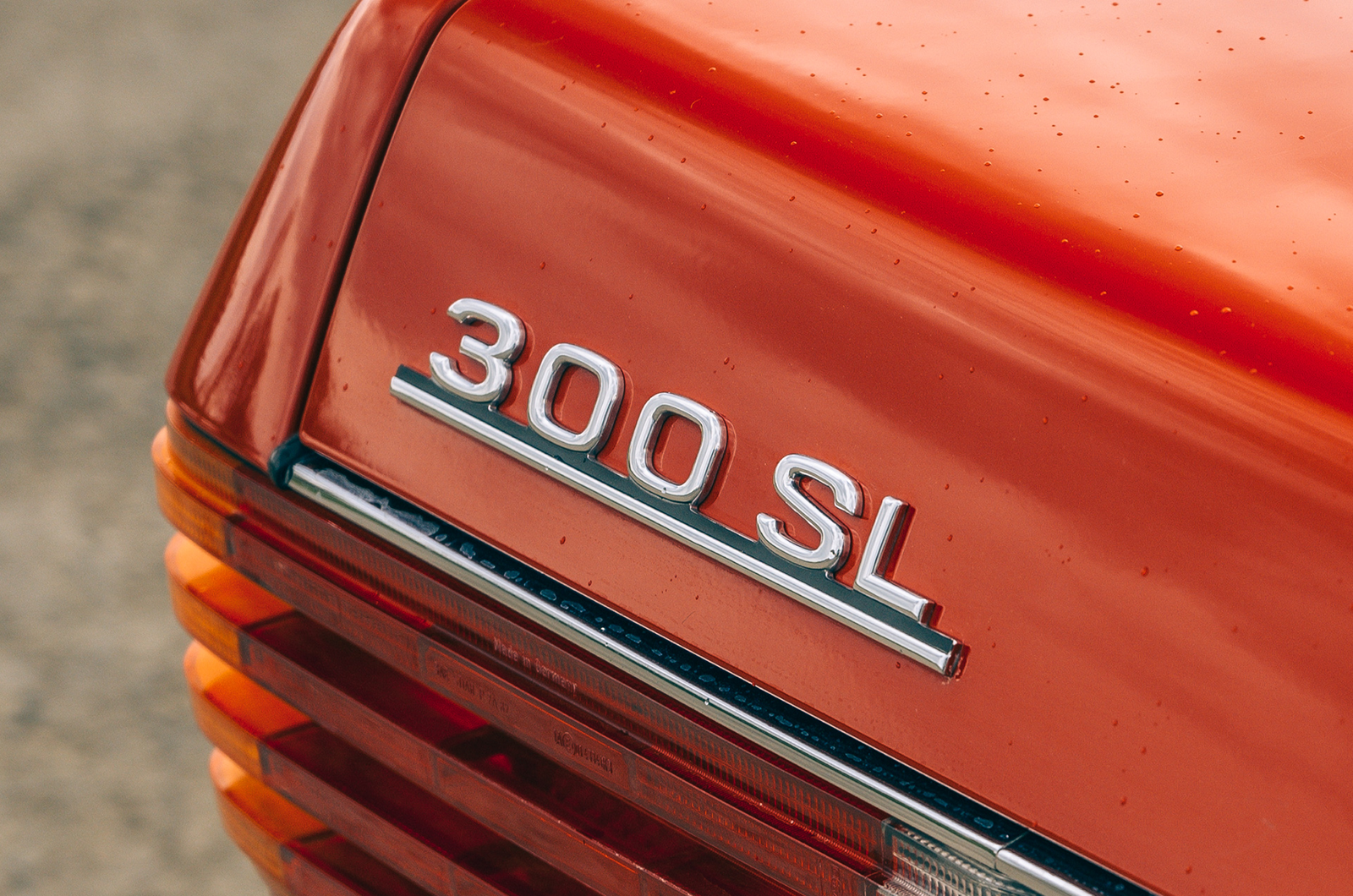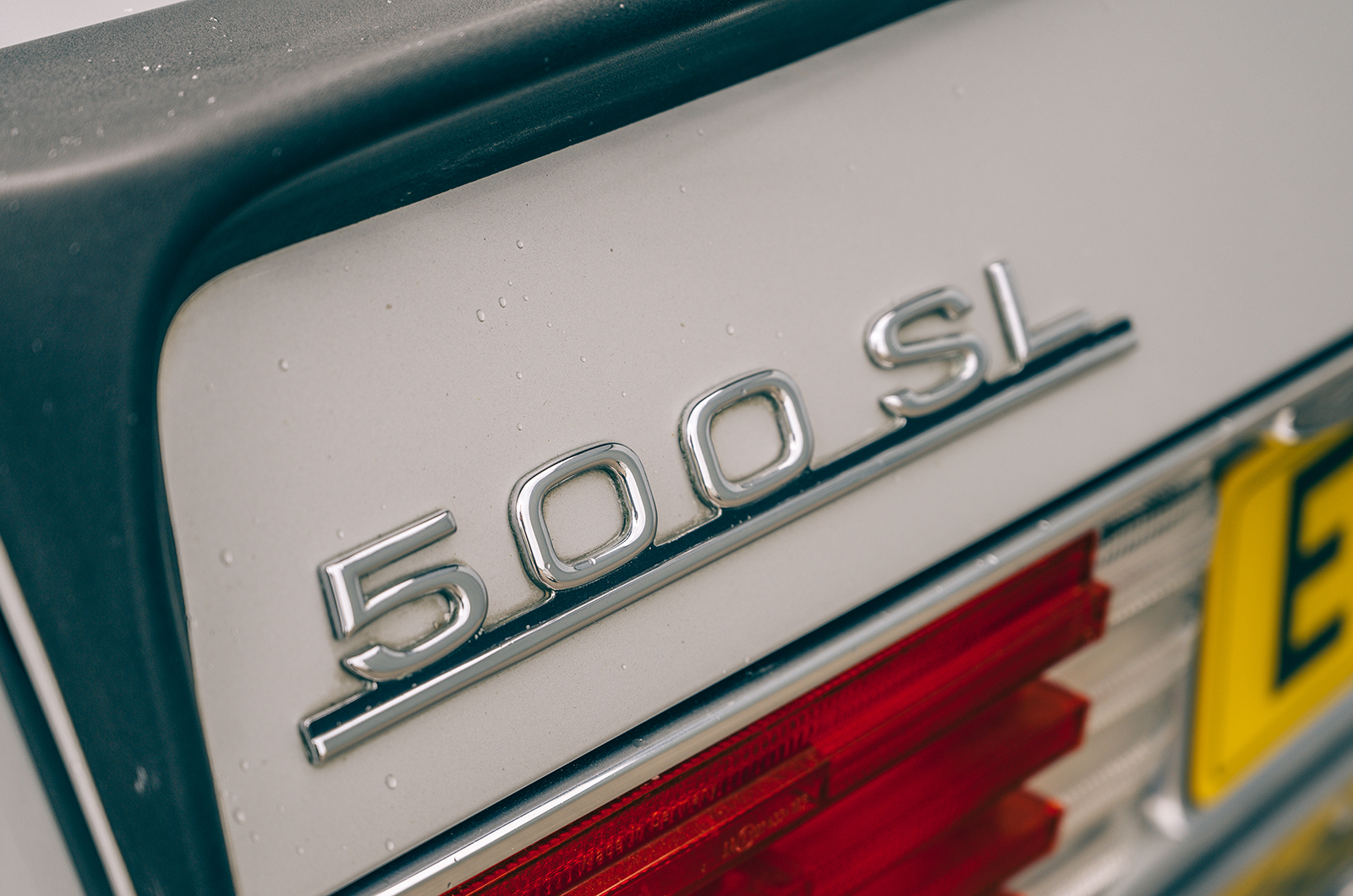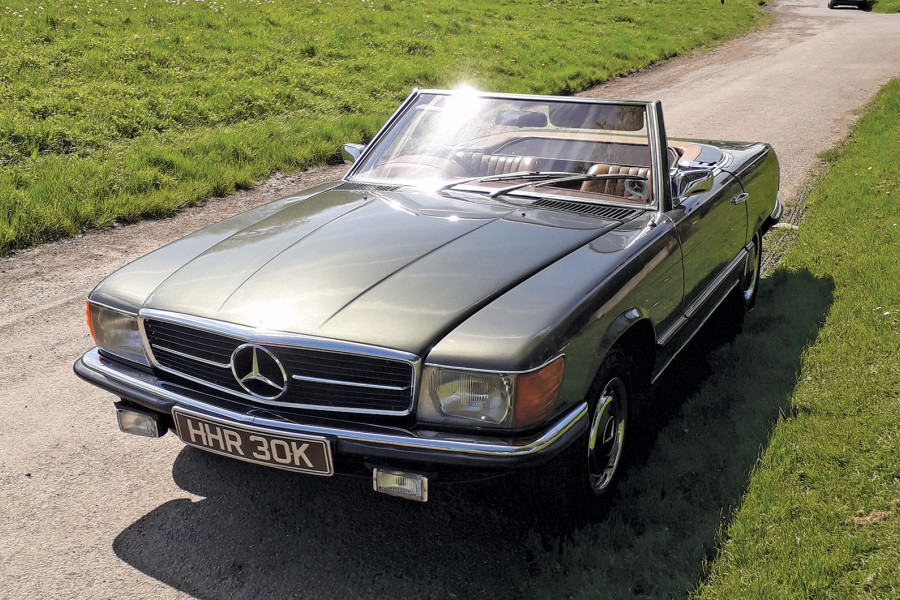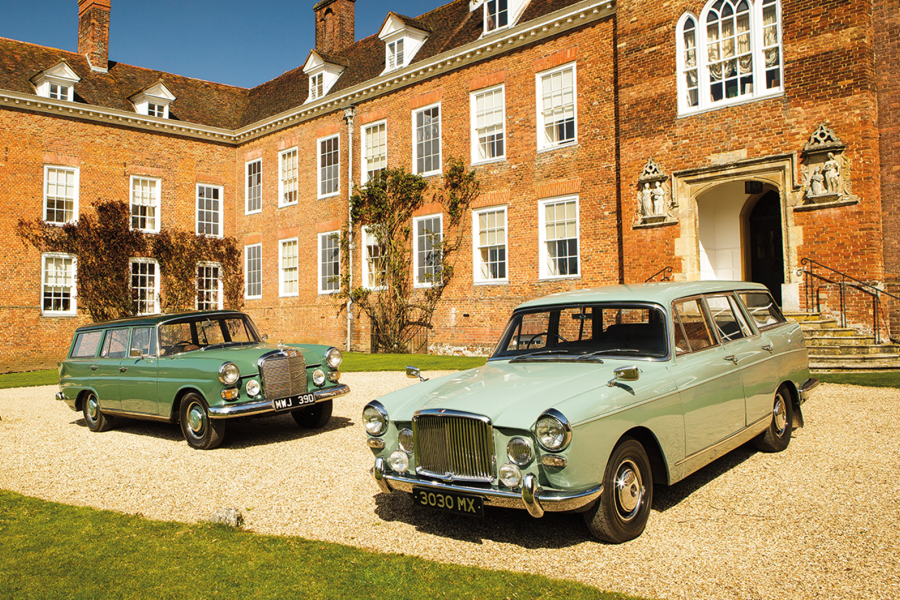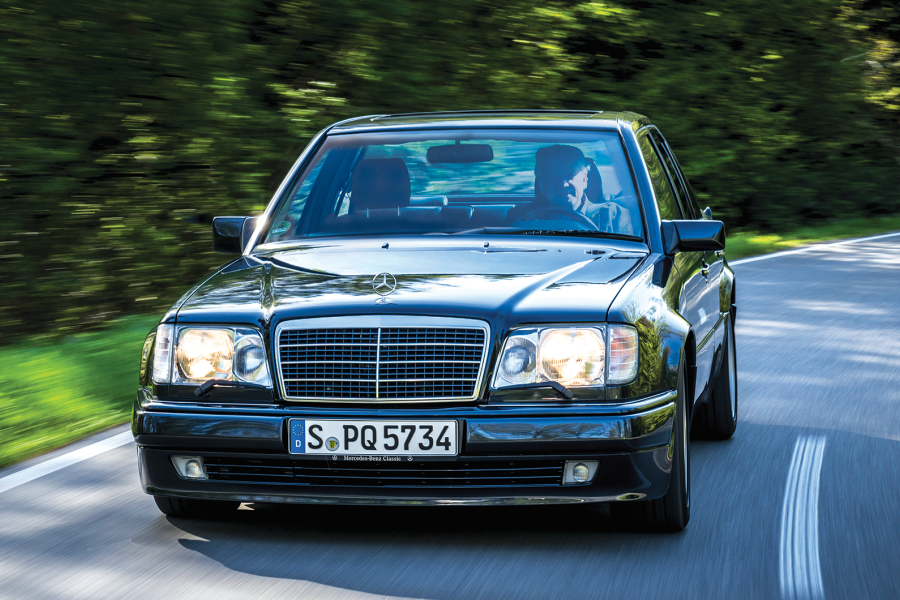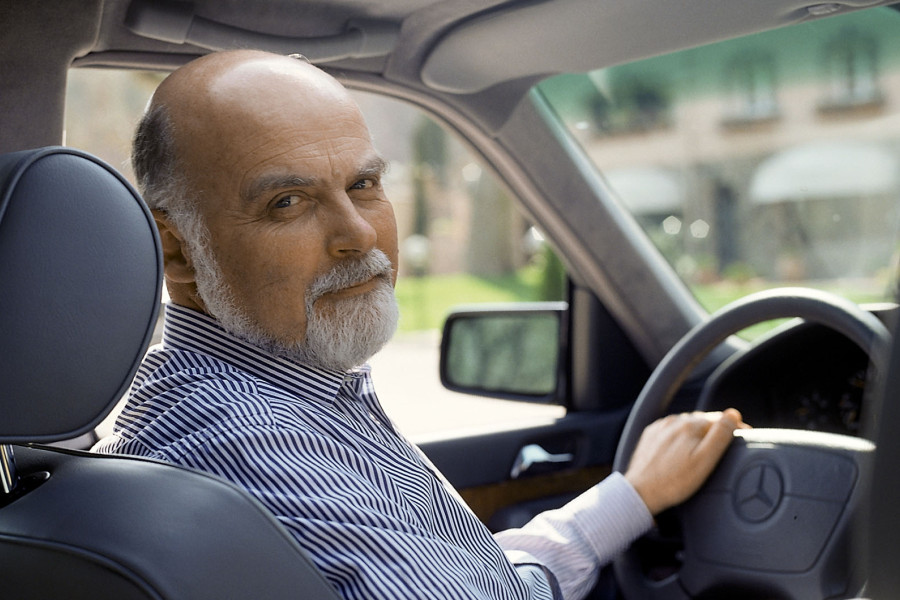Improved inlet valves and new cam profiles teased further horsepower out of the 500 in 1985 for a lusty 245bhp, with enough torque to give its now standard-fit limited-slip differential a workout.
At the same time the 380SL became the bored-out 420SL and the 280SL was replaced by the evocatively named 300SL, powered by the latest canted-over 188bhp single-overhead-cam straight-six first seen in the W124 300E.
Charming period fabric upholstery for this straight-six powered 300SL
On all models the front suspension geometry got less offset, lower-profile tyres were introduced (on flat-face alloys) and a chin spoiler was added to reduce front-end lift.
The 560SL was an export-only model, heading to North America, Japan and Australia, restricted to 230bhp by emissions equipment.
Barely 1000 Pagoda SLs came to the UK but the R107s were much more in evidence and are still a fairly regular sight today.
Most of the nice ones seem to end up at the SL Shop in Warwickshire, which furnished us with an early 350SL, a high-spec leather-trimmed 500SL and a straight-six 300SL to get a feel for how the cars developed through the 1970s and ’80s.
Mercedes’ styling of the R107s was a big leap on from the W113 Pagoda
In Icon Gold with the full hubcaps, the 350SL is a real period piece to look at, a true slice of ’70s chic compared to the slightly golf-club smugness of later variants.
After the ‘Italian coffee bar’ interior look of the Pagoda, Mercedes-Benz discovered injection mouldings for its plastic dashboards in the ’70s – colour-matching them to the external hue – and offered cloth inserts in addition to the usual MB-Tex or leather for the well-shaped seats.
The later SLs have veneers for the centre console, with a token sliver across the dash, but I like the honest austerity of the early car, if not the wrinkly rim of its massive steering wheel.
The 300 and 500 have the same design of four-spoke helm but, somehow, the leather cover gives a much more pleasant impression as you guide them through the Warwickshire lanes.
The 350SL’s tan interior is a brilliantly period choice and more flamboyant than the other two later cars pictured here
With its headgear in place the 350SL is like a small saloon that just happens to have two seats and superb 360º vision.
With their taut, beautifully tailored hoods lowered, windows up and furnace-like heaters blasting away, the 300 and 500 are cosy ways to enjoy the sights, sounds and smells of the countryside in springtime.
The 350SL, from 1974, has quite a gentle feel on the road. It rolls visibly more than the later cars, and has slower and less accurate steering, although weight and feel are good in all three.
Mercedes’ R107 SL is still as popular as ever
Its gearbox is there to be used if you want to extract performance; the selector works precisely in the D-S-L gate and the fluid coupling gives a positive feel to the changes compared to the seamless action of the torque-converter-equipped sport/economy transmissions in the 300 and 500.
They are higher geared than the 350, in which 80mph equals 4000rpm.
In all versions you must engage ‘L’ from rest or push past the resistance at the end of the long accelerator travel to get bottom gear.
The 350 and 300 feel equally matched in their strong and lively, rather than startling, straight-line urge.
Roof-up, the R107 blurs the lines between roadster and coupé or saloon
With throttle floored the meaty 500 squats hard on its rear suspension, leaving several yards of burnt rubber in its wake and shoving you up the road with a silky thrust that keeps on coming.
The 350 V8 sounds almost fussy compared to the way the baby 300, with its hydraulic tappets, sings round to 6500rpm.
I was left with the feeling that the lusty and lively six-pot R107, with all the late chassis tweaks and refinements, might just be the sweet spot of the range if you are ready to forgo V8 mystique and the period charm of the 1970s SLs.
All versions handle and ride well: substantial without being cumbersome, despite a huge steering wheel that irritated critics for 18 years, and with mild, gently understeering manners that incorporate large margins of safety.
An impressive lack of scuttle shake is common to all models, combined with a useful lock that makes them easy cars to manoeuvre.
It is hard to believe that Mercedes’ R107 SL is celebrating its half century
More than just transport, 50 years on the essential appeal of the R107 remains that of a compact, ‘personal’ and handy possession that manages to combine refinement and creature comforts without feeling in any way decadent, fragile or temperamental.
A special car but not an exotic one: a ‘lifestyle’ automobile and timeless default statement of affluence that resonated even with those who had only a passing interest in cars.
The luxury roadster everyone’s mum dreamed of – and quite a few dads, too.
Images: Olgun Kordal
Thanks to SL Shop
Factfile
Mercedes-Benz R107 SL
- Sold/number built 1971-’89/237,387
- Construction steel monocoque
- Engine iron-block, alloy-head, dohc 2746cc or sohc 2962cc straight-six, sohc-per-bank 3499/4520cc V8, or all-alloy 3818/3839/4196/4973/5547cc V8, all with fuel injection
- Max power 180bhp @ 5700rpm to 245bhp @ 5000rpm
- Max torque 176lb ft @ 4500rpm to 297lb ft @ 3200rpm
- Transmission four/five-speed manual or three/four-speed automatic, RWD
- Suspension independent, at front by double wishbones rear semi-trailing arms; coil springs, telescopic dampers, anti-roll bar f/r
- Steering power-assisted recirculating ball
- Brakes discs, with servo; optional anti-lock from 1980
- Length 14ft 3½in (4390mm)
- Width 5ft 8¾in (1790mm)
- Height 4ft 2½in (1300mm)
- Wheelbase 8ft (2460mm)
- Weight 3307-3781lb (1500-1715kg)
- 0-60mph 9.3-7.1 secs
- Top speed 126-140mph
- Mpg 15.4
- Price new £6995 (350SL, 1973)
- Price now £15-60,000
The R107 SL’s place in the classic market
Sam Bailey once had a ‘proper job’ in insurance, but quit 13 years ago after meeting fellow Mercedes-Benz enthusiast Bruce Greetham to start the SL Shop. Today, it has 50 employees at its premises near Stratford-upon-Avon.
While Bailey guides the brand direction, growing the SL customer base for buying, selling, restoring and selling parts, Greetham, who has a background in the haulage business and fell in love with Mercedes engineering when servicing his guvnor’s W124, has developed the showrooms and workshops where many of the staff are Mercedes-trained, including one veteran mechanic who pre-delivery inspected R107s when they were new.
“There are not many 1970s SLs left,” says Greetham. “Most have been bodged and been through a lot of hands but, in the future, I think real enthusiasts will buy the early cars. There is a turn in values coming with the 40-year-old-plus, tax-exempt SLs because of the period charm.
“Having said that, the market is still strong for the late cars because they are a little bit more fuel efficient and they give you a little bit more confidence when you drive them. There will always be buyers for good 500s and 300s with the right mileage and the right history. The 300 is a super-crisp and nicely balanced car, which you can push if you really want to.”
Will R107s catch up with Pagoda values? “I think if you cherry-pick the right models, yes: 500SLs in the right colours with low miles are already £60-75k cars. But they have to be right.
“We have sold some heavy £80-90,000 R107s in the past 12 months. When we sell those we need to find the person who really appreciates what they are, all the preserved detail.
“We are trying to get drivers back into the right cars after COVID-19, which has changed things a bit because people are deciding if they want an investment car or something to drive and enjoy on the basis that life’s too short.
“The 45-60,000 miles bracket is a sweet spot here – not so low that you mind putting the miles on it, but still sharp enough to use. Even if you put 10k miles in the next 10 years on an SL like that it will be worth 25% more by then anyway.
“Some parts are getting a bit scarce and Mercedes keeps putting up the prices, which means getting average cars up to a better level is going to be prohibitive for people in the years to come. Some parts are not of the quality they were years ago but, on the other hand, some of the pattern parts can be good.”
READ MORE
Glamour models: Mercedes-Benz 280SE 3.5 Coupé vs Rolls-Royce Silver Shadow MPW
How Britain nearly missed Mercedes’ brilliant 230TE
Mercedes-Benz 450SLC 5.0: the world’s least likely rally car?
Martin Buckley
Senior Contributor, Classic & Sports Car

